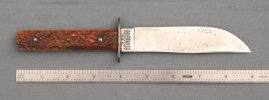Codger_64
Moderator
- Joined
- Oct 8, 2004
- Messages
- 62,324
I like exploring the old patterns made by Camillus and the knives they imported for sale here. I just bought a fixed blade that I have never seen an example of before.
Previously I have bought their Sportsman pattern, eventually acumulating three of them. Simple plain flat ground blades, guardless construction, full tang with pinned rosewood handle covers. These were well made, full polish and branded by Camillus for sale to F. W. Woolworths as low price point hunting knives.

Recently I acquired a knife similar in ways to the first, earlier knife, but it is not a hunting knife. It is a hawkbill utility knife with upscale features over it's sibling sportsman pattern. The tang marking is unmistakably similar, but the utility knife has jigged (wood? bone?) handle covers attached to the full tang with domed brass rivets instead of brass pins.



The knife is not yet in hand so I cannot say definately what the handle material is, other than what can be seen in the auction pictures. At first I thought it was jigged bone but after looking closely, I am thinking it may be stamped impressed wood? Anyway, the tang mark similarities between the plain-jane Kent Sportsman and the utility knife suggest to me that they were made and sold to Woolworths during the same timeframe. Mid 1930's?
Previously I have bought their Sportsman pattern, eventually acumulating three of them. Simple plain flat ground blades, guardless construction, full tang with pinned rosewood handle covers. These were well made, full polish and branded by Camillus for sale to F. W. Woolworths as low price point hunting knives.

Recently I acquired a knife similar in ways to the first, earlier knife, but it is not a hunting knife. It is a hawkbill utility knife with upscale features over it's sibling sportsman pattern. The tang marking is unmistakably similar, but the utility knife has jigged (wood? bone?) handle covers attached to the full tang with domed brass rivets instead of brass pins.



The knife is not yet in hand so I cannot say definately what the handle material is, other than what can be seen in the auction pictures. At first I thought it was jigged bone but after looking closely, I am thinking it may be stamped impressed wood? Anyway, the tang mark similarities between the plain-jane Kent Sportsman and the utility knife suggest to me that they were made and sold to Woolworths during the same timeframe. Mid 1930's?





